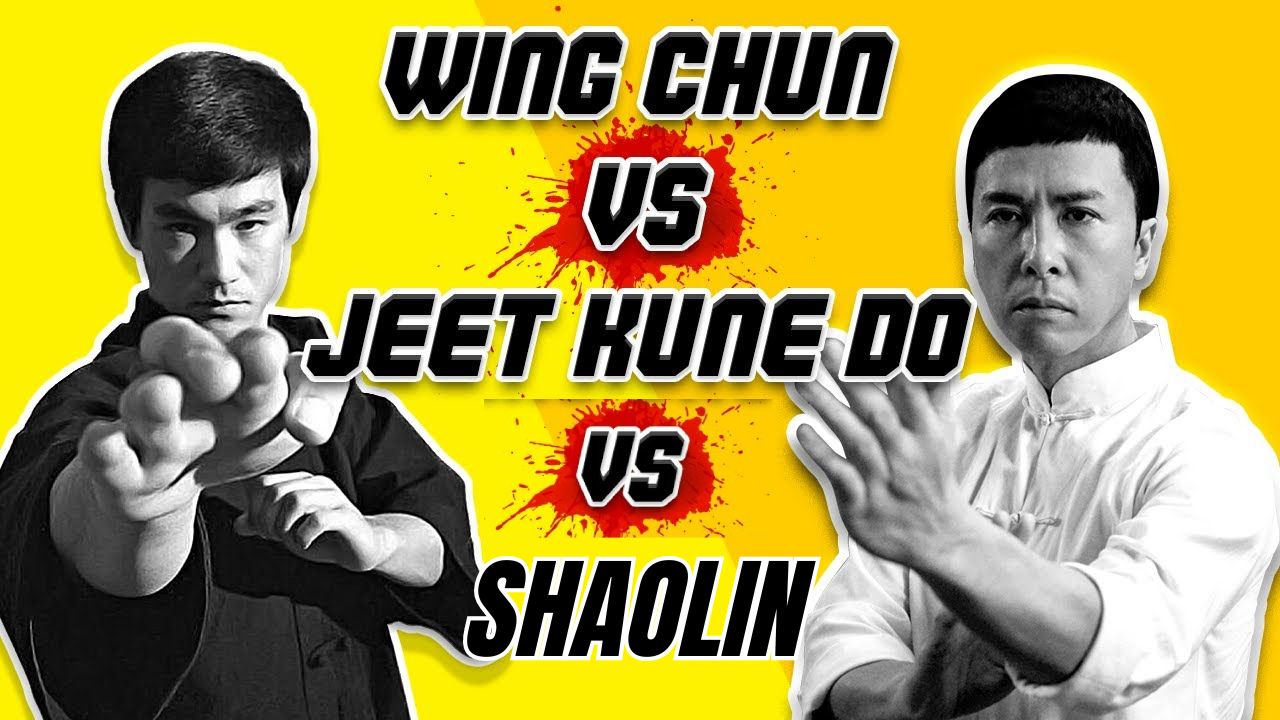
In the realm of martial arts, few styles command as much respect and intrigue as Shaolin Kung Fu, Wing Chun, and Jeet Kune Do. Each represents a unique blend of philosophy, history, and technique, captivating the world with their power, elegance, and effectiveness.
Each style has evolved and adapted to modern society. Shaolin Kung Fu has integrated fitness and wellness practices, Wing Chun has been popularized through self-defense courses, and Jeet Kune Do continues to inspire martial artists to innovate and personalize their training.
While often compared and contrasted, they stand as distinct paths to mastery. This article embarks on a journey to explore the depths of these martial arts titans.
The Mythical Battle
Imagine a clash between mythical figures representing these three styles: Shaolin, the towering monk, grounded in discipline and spiritual depth; Wing Chun, the elusive shadow, focused on efficiency and precision; and Jeet Kune Do, the mercurial warrior, unbound by tradition. Their confrontation would be a cosmic dance of opposing forces, a mesmerizing ballet of brutality.
While this battle remains a realm of myth, its echoes resonate in the hearts of martial artists worldwide. By examining the histories, philosophies, techniques, and cultural impacts of these styles, we can gain a deeper appreciation for their unique contributions to the world of martial arts.
Shaolin Kung Fu represents The Monastery of Warriors
Rooted in the heart of China's Henan province, the Shaolin Temple stands as a beacon of martial and spiritual cultivation. Legends paint a picture of Buddhist monks defending their sanctuary, forging a unique blend of combat and meditation. Over centuries, Shaolin Kung Fu evolved into a comprehensive system encompassing striking, grappling, weapons, and internal energy cultivation.
Physical Techniques
Shaolin Kung Fu masters a vast array of techniques, including powerful kicks, strikes, and intricate grappling maneuvers. Their training is rigorous, focusing on strength, speed, flexibility, and coordination. Signature techniques include:
- Whirlwind Kick: A spinning kick that combines speed and power, used to surprise opponents.
- Buddha Palm: A powerful open-hand strike that emphasizes both strength and energy projection.
- Five Animal Styles: Techniques inspired by the movements of animals (Tiger, Crane, Snake, Leopard, and Dragon), each embodying different attributes.
Philosophy
Rooted in Zen Buddhism, Shaolin emphasizes discipline, perseverance, and harmony. The concept of *Qi* (vital energy) is central, with practitioners seeking to cultivate and channel it for enhanced power and awareness. This philosophy extends beyond martial arts, influencing personal development and mindfulness practices.
Bodhidharma, the legendary monk, is credited with bringing Zen Buddhism to China and establishing the foundations of Shaolin martial arts. His teachings emphasized the integration of physical training and meditation.
Shaolin Kung Fu teaches the importance of balance between mind and body, emphasizing the journey of self-discovery.
Cultural Impact
Shaolin has permeated popular culture through cinema, influencing the image of the warrior monk. Its philosophical underpinnings have also influenced Western concepts of mindfulness and meditation, making it a symbol of martial arts worldwide.
Wing Chun is The Art of Efficiency
Born amidst the chaos of 17th-century China, Wing Chun is a testament to practicality and efficiency. Attributed to Yim Wing Chun, a young woman who allegedly developed it to defend herself against a larger opponent, the style prioritizes close-range combat and economy of motion.
Physical Techniques
Wing Chun focuses on trapping, striking, and controlling the opponent's limbs. Key techniques include:
- Bong Sao (Wing Arm): A defensive technique that redirects an opponent's force while maintaining a strong structure.
- Tan Sao (Plucking Hand): A technique used to deflect incoming strikes while preparing for a counterattack.
- Chain Punching: A rapid series of punches to overwhelm the opponent, emphasizing speed and precision.
Philosophy
Wing Chun emphasizes simplicity, directness, and adaptability. The concept of *simultaneous attack and defense* is central, reflecting the style's focus on practicality. This efficiency allows practitioners to respond effectively in real combat scenarios.
Ng Mui, a Buddhist nun and one of the Five Elders of Shaolin, is credited with developing Wing Chun as a response to the need for an efficient fighting style that favored technique over brute strength.
Wing Chun promotes the idea of overcoming obstacles through intelligence and technique rather than brute strength.
Cultural Impact
Wing Chun has gained popularity for its practical self-defense applications and has been featured in films, contributing to its overall recognition. The legacy of Grandmaster Ip Man, who taught Bruce Lee, has further solidified its place in martial arts history.
Jeet Kune Do is The Art of Expressing the Human Body
Created by the legendary Bruce Lee, Jeet Kune Do is less a style and more a combat philosophy. A departure from traditional martial arts forms, it emphasizes adaptability, directness, and the expression of the human body.
Physical Techniques
Jeet Kune Do incorporates techniques from various martial arts and real-life combat experience. Key aspects include:
- Intercepting Techniques: Attacking an opponent's movement before it fully develops, emphasizing timing and precision.
- Direct Attacks: Focusing on striking vital targets quickly and efficiently, often using simple techniques that require minimal movement.
- Adaptability: Practitioners are encouraged to develop their unique fighting style based on their body mechanics and understanding of combat.
Philosophy
Core principles of Jeet Kune Do include intercepting intent, water-like adaptability, and simplicity. Bruce Lee's philosophy encourages practitioners to discard what is useless and embrace what is useful, fostering a personalized approach to martial arts.
Bruce Lee, a cultural icon, revolutionized martial arts with his creation of Jeet Kune Do. His philosophy encouraged breaking free from traditional constraints and focusing on what was effective in combat.
Jeet Kune Do encourages practitioners to embrace change and innovation, reflecting Bruce Lee's belief in the fluidity of martial arts.
Cultural Impact
Bruce Lee's charisma and revolutionary approach to martial arts made Jeet Kune Do a cultural phenomenon. His films popularized the idea of fluid, expressive fighting styles, influencing countless action movies and TV shows, and inspiring martial artists around the globe.
Deeper Dive into Techniques
Specific Techniques
- Shaolin Kung Fu: The *Whirlwind Kick* is executed by pivoting on one foot and using the other to deliver a high, spinning kick, blending agility with power. The *Buddha Palm* utilizes an open hand to deliver a powerful strike, often used in combination with footwork to evade attacks.
- Wing Chun: The *Bong Sao* is practiced by raising the arm in a wing-like formation, allowing for effective deflection and countering. The *Chain Punching* technique involves a rapid succession of punches delivered from the centerline, maximizing efficiency in close combat.
- Jeet Kune Do: The *Intercepting Punch* is a hallmark technique where the practitioner strikes as the opponent initiates an attack, demonstrating the principle of attacking first. This requires keen observation and timing to execute effectively.
Comparison
| Feature | Shaolin Kung Fu | Wing Chun | Jeet Kune Do |
|---|---|---|---|
| Origin | Ancient China (Shaolin Temple) | 17th Century China | 20th Century (Developed by Bruce Lee) |
| Philosophy | Discipline, Harmony, Spiritual Development | Efficiency, Practicality | Adaptability, Expressing the Human Body, Intercepting Intent |
| Techniques | Diverse (striking, grappling, weapons) | Close-range, Efficiency, Structure (trapping, striking, controlling limbs) | Adaptable, No Fixed Forms (incorporates techniques from various styles) |
| Advantages | Well-rounded, Powerful Techniques, Spiritual Benefits, Promotes Strength, Flexibility, and Coordination | Effective in Close Quarters, Easy to Learn Basics, Suitable for Self-Defense, Develops Strong Body Mechanics | Direct and Effective, Adaptable to Any Situation, Develops Fighting Mindset and Awareness |
| Disadvantages | Complex to Learn Entire System, Requires Dedication and Time Commitment, Less Emphasis on Practical Self-Defense | Limited Range (not ideal for long-distance fighting), Relies on Close Quarters, Requires Specific Body Type and Size for Optimal Effectiveness | No Set Forms Require High-Level Understanding of Fighting Principles, Less Structured Learning Curve, May Not Be Suitable for Beginners |
Practical Applications
- Shaolin Kung Fu techniques are often used in self-defense situations where strength and multiple attackers are factors. The diverse skill set allows for adaptability in various scenarios.
- Wing Chun is particularly effective in close-quarters combat, making it ideal for limited space. The emphasis on quick, efficient strikes allows practitioners to neutralize threats rapidly.
- Jeet Kune Do techniques are applicable in real-life situations where unpredictability is a factor. The philosophy of adapting to the opponent's movements allows for effective responses regardless of the combat environment.
Training and Practice
Physical Conditioning
- Shaolin Kung Fu training involves rigorous physical conditioning, including strength training, flexibility exercises, and cardiovascular conditioning. Practitioners engage in forms, sparring, and weapon training to develop a well-rounded skill set.
- Wing Chun emphasizes functional strength and agility, with training routines focusing on footwork drills, partner exercises, and conditioning to enhance speed and reflexes.
- Jeet Kune Do training is highly adaptable, often incorporating elements from various martial arts to develop a versatile skill set. Practitioners focus on real-life scenarios and sparring to refine their techniques.
Mental Preparation
Mental aspects of training are crucial across all styles.
- Shaolin Kung Fu incorporates meditation and mindfulness practices to enhance focus and emotional control.
- Wing Chun emphasizes mental clarity and adaptability, training practitioners to remain calm and responsive under pressure.
- Jeet Kune Do encourages a mindset of exploration and creativity, urging practitioners to find their unique path in martial arts.
Finding a Qualified Instructor
Finding a reputable instructor is essential for anyone looking to train in these martial arts.
- Shaolin Kung Fu schools often have a lineage tracing back to the original temple, ensuring authentic teachings.
- Wing Chun instructors should have a strong lineage, ideally tracing back to Grandmaster Ip Man or his students.
- Jeet Kune Do practitioners should seek instructors who emphasize Bruce Lee's philosophy and adapt it to modern training methods.
Respect, tradition, and etiquette play a vital role in martial arts training. Practitioners are encouraged to show respect to their instructors, fellow students, and the art itself. This includes bowing, maintaining a clean training environment, and adhering to the school's rules.
Injuries and Safety
Common injuries in martial arts include sprains, strains, and bruises. To prevent injuries, practitioners should:
- Warm-up and cool down properly.
- Use protective gear during sparring.
- Listen to their bodies and avoid pushing beyond their limits.
Conclusion
In conclusion, Shaolin Kung Fu, Wing Chun, and Jeet Kune Do stand as three distinct yet interconnected pillars within the martial arts world. Each style offers a unique blend of techniques, philosophies, and cultural heritage, contributing to the rich tapestry of combat arts. From the spiritual depth of Shaolin to the practical efficiency of Wing Chun, and the innovative spirit of Jeet Kune Do, these martial arts reflect the diverse paths individuals can take on their martial journey. By understanding their nuances, practitioners can gain a deeper appreciation for the evolution and complexity of martial arts.
Ready to delve deeper into these fascinating styles? For our VIP members, we've crafted comprehensive eBooks on Shaolin Kung Fu, Wing Chun, and Jeet Kune Do, exploring their history, philosophy, mindset, and training methods. Discover which style resonates with your martial spirit. Become a VIP member today and download your free eBooks!






